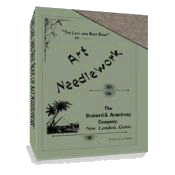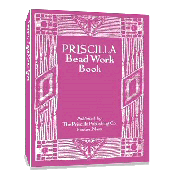Au Passe Stitch
or Flat Satin Stitch

The Au Passe Stitch is a flat Satin Stitch, worked across the material, with no raised foundation. This stitch is also called Point Passe (often spelled Passé), Passé, Long Stitch, and Satin Stitch. It is used in all kinds of embroidery upon linen, silk, satin, and velvet, and is much employed in church work. Anything that can be threaded through a needle will embroider in Au Passé.
In Fig. 1, below, is an illustration of embroidery upon silk, in which this stitch forms the chief stitch, surrounded in some places by a border of Stem or Crewel Stitch; in others it forms its own outline, but in all cases follows the curves and lines of the arabesque fruit and foliage it delineates.

Fig. No. 1 — Au Passé on Silk
Click on picture to see more detail.
The following illustration (Fig. 2), represents a group of flowers embroidered in Au Passe stitch, with colored silks upon satin. This should be worked in a frame and the satin backed with muslin.

Fig. No. 2 — Au Passé
Click on picture to see more detail.
To work: The materials required: a silk or satin foundation and embroidery silks; colors: shades of olive green, art blues, and yellow pinks, with gold thread. Make the stitch by bringing the needle from back of the frame up in the center of the leaf or inner part of petal, and putting it back again at the outer side. These long stitches must follow the curves of the leaf or flower.
The above information was edited from The Dictionary of Needlework, by S.F.A. Caulfeild 1882.
Return to top of Au Passe Stitch page.
Return to Embroidery Stitches page.
The Last and Best Book of Art Needlework
Over 100 pages of authentic Victorian instructions and patterns from 1895!
FREE
Beeton's Book Of Needlework

433 pages!
Sign up for VEAC! Everything you wanted to know about Victorian embroidery, needlework, crafts and more!
Priscilla Bead Work Book
Make Beautiful Victorian Beaded Purses, Jewelry & Accessories - Starting
TODAY!



